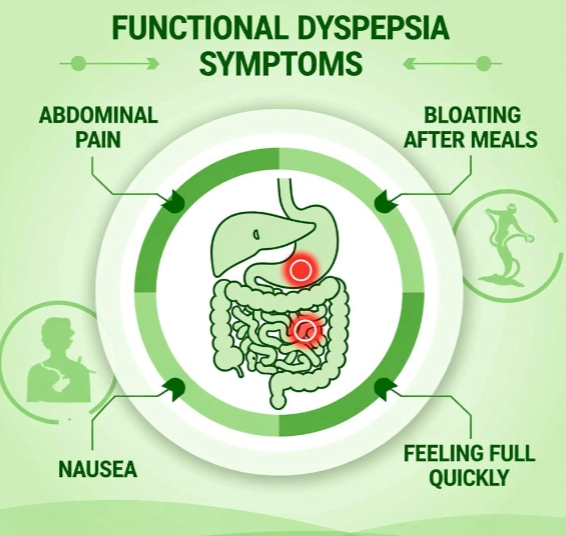Main Symptoms of Functional Dyspepsia
Functional dyspepsia is a chronic upper-gut disorder in which epigastric pain or discomfort is not explained by structural disease, medications, or metabolic causes. Symptoms fluctuate over months, often begin in early adulthood, and may coexist with anxiety, migraine, or irritable bowel syndrome. Recognising the typical pattern avoids unnecessary imaging and guides targeted therapy.
- Core epigastric complaints
Post-prandial fullness: a heavy, bloated sensation that starts soon after the first bites and may last more than two hours.
Early satiation: feeling “suddenly full” before finishing a normal-sized meal, leading to reduced food intake and sometimes weight concern.
Epigastric pain: burning, gnawing, or vague soreness localized between the costal margins; not relieved by acid suppression alone in many patients.
Epigastric discomfort: a dull, pressure-like sensation that can spread to the xiphoid or lower ribs, often mistaken for cardiac pain. - Associated upper-gut features
Belching and visible gastric distension: swallowed air and delayed fundic relaxation contribute to repetitive, involuntary eructations.
Nausea: mild to moderate, rarely progressing to vomiting; tends to appear when pain peaks.
Regurgitation of sour or bitter fluid: usually without heartburn, distinguishing the condition from typical reflux disease.
Hypersensitive bloating: patients describe “a balloon” in the upper abdomen even when objective distension is minimal. - Timing and triggers
Symptoms are present at least three days per week for the last three months, with onset six months before diagnosis. Meals, stress, poor sleep, and menstrual phase often amplify complaints, while fasting or small-volume snacks may provide temporary relief. - Exclusion clues (red flags)
Persistent vomiting, dysphagia, overt gastrointestinal bleeding, unintentional weight loss >5 % within six months, iron-deficiency anemia, or palpable epigastric mass—these warrant endoscopy and imaging to rule out organic disease.
Summary table
| Symptom | Quality | Typical timing | First-line patient action |
|---|---|---|---|
| Post-prandial fullness | Heavy, bloated | Starts within minutes of eating | Smaller, low-fat meals; chew slowly |
| Early satiation | Sudden stop | Mid-meal | Split meals; avoid carbonated drinks |
| Epigastric pain | Burning/gnawing | Empty or full stomach | Warm compress; acid-suppressant trial |
| Belching | Repetitive, involuntary | During and after food | Eat upright; limit gum, straw use |
| Nausea | Mild, no vomiting | Peaks with pain | Ginger tea, paced breathing |
